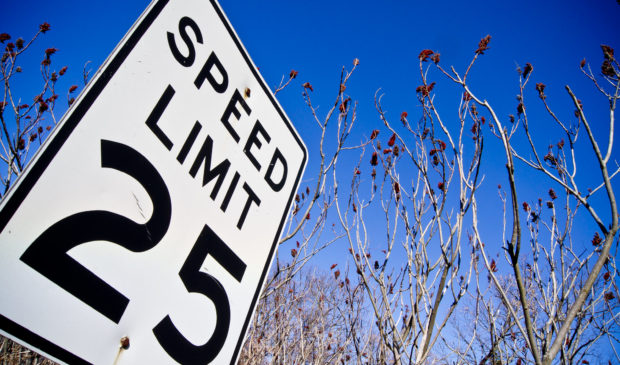City advances speed management projects
Wednesday, October 7, 2020 by
Ryan Thornton On the heels of an ongoing citywide speed limit reduction program, the Austin Transportation Department has launched a new traffic calming program to help retrofit Austin’s streets for an increasingly urban environment.
The speed mitigation program is intended to complement speed limit reductions with street design modifications and address the fact that, while total crashes and serious injuries are on the decline from last year, both speeding and traffic fatalities in the city are on the rise. For the initial set of speed mitigation projects, the department has selected 14 roadway segments – 11 of which are east of Interstate 35 – that can be improved with existing department funding.
The proposed design improvements are lumped into three general categories that are further detailed in the city’s new traffic calming toolkit: horizontal deflection, vertical deflection, and speed monitoring and awareness tools. The document includes a variety of design features like curb extensions, roundabouts, speed humps, raised crosswalks, digital driver speed displays and Vision Zero yard signs.
Street design modifications are expected to begin this winter and conclude by the end of 2021 on the following roadway segments:
- Springdale Road from Airport Boulevard to Martin Luther King Jr. Boulevard
- Webberville Road from Springdale Road to MLK Jr. Boulevard
- Heflin Lane from Springdale Road to Webberville Road
- Rosewood Avenue from East 11th Street to Webberville Road
- Bolm Road from Springdale Road to Shady Lane
- Crystalbrook Drive from Loyola Lane to Pecan Brook Drive
- Briarcliff Boulevard from Cameron Road to Berkman Drive
- Blessing Avenue from Atkinson Road to East Anderson Lane
- Colony Park Drive from Loyola Lane to Ritchie Drive
- Powell Lane from Georgian Drive to I-35
- Peppertree Parkway from East Stassney Lane to Teri Road
- Blue Meadow Drive from Bluff Springs Road to Meadow Lake Boulevard
- Palace Parkway from West Slaughter Lane to West Dittmar Road
- Abilene Trail from Convict Hill Road to Beckett Road
According to a recent memo from department Director Robert Spillar, the selected projects “represent a substantially small portion of the entire citywide need” to manage speeds on neighborhood streets.
In total, the department considered 150 street segments before selecting the initial 14 project locations based on crash and speed history as well a matrix of community context points like economic and racial diversity, sidewalk conditions and nearby destinations. A map of the scored and selected streets is available on the speed management web page.
To make the most of existing funds, the department plans to prioritize “low-cost, high-impact” strategies during the first phase of the speed mitigation program, progressing with more substantial investments as needed. The department plans to request additional funds next spring to further expand the program. Additional funds may also be available if voters approve Proposition B next month. The $460 million active mobility bond includes $64 million for safety improvements and Vision Zero efforts and $53 million for improvements to substandard streets.
Crash data and changes to community context will be updated on an annual basis in order to re-score and reprioritize the street network for speed mitigation improvements.
Among the strategies listed in the horizontal deflection section of the toolkit are chicanes, a series of midblock curb extensions or traffic medians that were installed using traffic barrels as part of this year’s Healthy Streets initiative. The department has added the strategy and others to both the upcoming Transportation Criteria Manual and the Sidewalk Plan currently under revision.
Going forward, the department will complete context-appropriate designs for the 14 street segments and present the designs in a series of socially distanced neighborhood meetings. Spillar said the designs will be revised as needed based on public feedback.
Photo made available through a Creative Commons license.
The Austin Monitor’s work is made possible by donations from the community. Though our reporting covers donors from time to time, we are careful to keep business and editorial efforts separate while maintaining transparency. A complete list of donors is available here, and our code of ethics is explained here.
You're a community leader
And we’re honored you look to us for serious, in-depth news. You know a strong community needs local and dedicated watchdog reporting. We’re here for you and that won’t change. Now will you take the powerful next step and support our nonprofit news organization?







